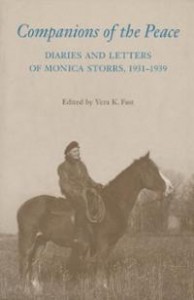Contemporary Church History Quarterly
Volume 19, Number 3 (September 2013)
Book Note: Vera K. Fast, ed., Companions of the Peace Diaries and Letters of Monica Storrs, 1931-1939 (Toronto: University of Toronto Press, 1999), ISBN 0-8020-8254-8, 246 Pp.
By John S. Conway, University of British Columbia
In November 1938, one of the more remarkable responses to Hitler’s brutal pogrom against the German Jews—the Kristallnacht—came from a remote Anglican parish in distant northern British Columbia.
Monca Storrs, the parish worker at St Martin’s Church, Fort St. John, in the newly settled Peace River District, was so outraged that she spontaneously contacted George Bell, the Bishop of Chichester and chairman of the Church of England Committee for non-Aryan Christians, and offered to sponsor and act as guardian to two young victims, if the bishop could arrange for them to be brought to England, and if they were willing to come out and live in what she described as “the very western edge of the British Empire”.
 Monica was a cultured English gentlewoman who had volunteered in 1931 to come out to western Canada to help build up the Anglican Church amongst the isolated and often impoverished homesteaders of the Peace Dictrict. Luckily, at the end of 1938, Monica was taking a home leave, so she was able to meet the two German boys when they arrived in England on one of the “Kindertransporte” which rescued several thousand children in the few short months before the outbreak of war.
Monica was a cultured English gentlewoman who had volunteered in 1931 to come out to western Canada to help build up the Anglican Church amongst the isolated and often impoverished homesteaders of the Peace Dictrict. Luckily, at the end of 1938, Monica was taking a home leave, so she was able to meet the two German boys when they arrived in England on one of the “Kindertransporte” which rescued several thousand children in the few short months before the outbreak of war.
Horst, later Hugh, Schramm and Arwed, later David, Lewinski had been selected through the Society of Friends office in Berlin, where Bishop Bell’s sister-in Law, Laura Livingstone, took care of the transport and the paperwork involved. The children had to say goodbye to their parents on the Berlin railway station platform, not knowing when or if they would ever meet again. In Hugh’s case, his father was killed fighting in Russia, but his mother managed to escape to Shanghai. She and her son were later reunited when she migrated to the United States after the war was over. In David’s case, both his parents were deported to Auschwitz, where his mother died but his father survived. In 1953 David was at last able to fly over to Germany to meet his father again, after fourteen cruel years of separation.
Monica had hoped to bring the boys back with her to Canada when she returned in 1939, but bureaucracy intervened. The Canadian government was still reluctant to admit Jewish refugees, even Christian ones. On her way home, she stopped off in Ottawa to intervene personally with the immigration officials and even secured an interview with the Governor-General, Lord Tweedsmuir, to ask for his help. But it took a year before permission was granted for the boys to accompany a group of English children being evacuated to Canada. Eventually they arrived in British Columbia to be greeted most warmly by Monica and her colleagues in the community she had established as the Companions of the Peace.
This generous response undoubtedly saved the lives of these two refugee boys. But for years this international and humanitarian gesture remained unknown. This book shows us this inspiring example of one woman’s resolute service and outreach from furthest western Canada to help alleviate the terrible crimes of the Holocaust.
